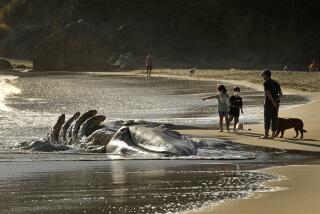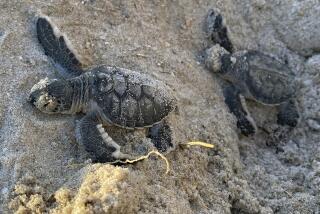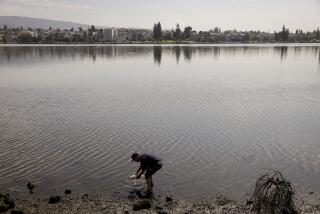Gulf fishing nets, not oil, may be culprit in initial sea turtle deaths
Reporting from Seattle — Of the hundreds of sea turtles found dead along the Gulf Coast since the Deepwater Horizon oil-rig disaster, the majority examined so far appear to have died by drowning or aspirating sediment from the seafloor, a federal fisheries official said Thursday.
Early findings suggest that many of the endangered turtles may have died because they were getting caught in fishing nets, not the oil spill — at least in the immediate aftermath of the BP accident.
Investigators suspect that a last-minute shrimping season authorized after the April 20 blowout — and immediately before the first major wave of turtle deaths — could have led to the animals becoming trapped in trawlers’ nets.
But authorities have not ruled out the somewhat more remote possibility that a toxic algae bloom could have paralyzed the turtles and caused them to drown.
And Michael Ziccardi, a UC Davis veterinarian who leads the sea turtle and marine mammal oil spill response in the Gulf of Mexico, emphasized that necropsies have been conducted only on the first wave of turtles that washed up dead after the oil spill began.
“I would say that from the results of that first batch of animals, oiling does not seem to be a primary factor in their deaths. But they may still have been exposed, and it could have been a contributing factor. We don’t want to rule anything out,” Ziccardi said.
Barbara Schroeder, sea turtle coordinator for the National Marine Fisheries Service, said authorities had examined 67 turtle carcasses, 40 of them intact enough to conduct a full initial necropsy. Of those, 21 “showed various degrees of aspiration of black sediment into the respiratory system,” she said.
“There was no gross evidence of any significant infectious or underlying disease process as a cause of the strandings,” she said. “Drowning and asphyxia from sediment aspiration are primary considerations for the immediate cause of death for almost all animals for which complete examination was possible.”
The findings do not necessarily exonerate the oil spill. Many turtles covered heavily in oil probably sank to the bottom of the sea, scientists say. Others could have been weakened by ingesting oil or oil-soaked food.
Ziccardi said additional toxicology tests over the next few weeks would determine whether algae poisonings could account for the drownings.
“Ultimately, drowning is the primary factor in at least these 21 turtles. But the cause of that, whether it’s forced submergence through some type of human interaction, is yet to be determined,” he said.
Shrimp-trawler nets have long been a cause of accidental sea turtle drownings, but in recent years trawlers have installed escape hatches in their nets to allow turtles to escape. Scientists worry that the oil spill may have caused many fishermen to close the devices to catch as many shrimp as possible.
“It’s one of the questions that’s being asked, because these first few groups of turtles started coming in after the shrimping season was opened in Louisiana” on April 29, said Moby Solangi, director of the Institute for Marine Mammal Studies in Gulfport, Miss., where a number of the dead turtles were taken.
In all, 411 dead turtles have been recovered since the oil spill began, and 128 have been taken in alive, many of them covered in oil. A large number of the dead turtles are Kemp’s Ridley turtles, an endangered species that lives most of its life in the gulf.
More to Read
Sign up for Essential California
The most important California stories and recommendations in your inbox every morning.
You may occasionally receive promotional content from the Los Angeles Times.










